Wolf Spider
Scientific Name: Lycosidae (family)
Order & Family: Araneae, Lycosidae
Size: Body length typically ranges from 10 to 35 mm (0.4 to 1.4 inches), depending on the species.

Natural Habitat
Found in a variety of habitats including grasslands, forests, deserts, and suburban gardens. Many prefer to live on the ground among leaf litter, under rocks, or bark.
Diet & Feeding
Carnivorous, preying on insects and other small invertebrates. They actively hunt their prey rather than using webs to catch them.
Behavior Patterns
Nocturnal hunters, active on the ground. They are known for their speed and agility. Females often carry their egg sacs attached to their spinnerets and, after hatching, carry the spiderlings on their back for a period.
Risks & Benefits
Generally considered beneficial as natural pest control, consuming various garden pests. While capable of biting if provoked, their venom is not considered dangerous to humans, typically causing only localized pain, redness, and swelling similar to a bee sting. They are not aggressive towards humans.
Identified on: 11/5/2025